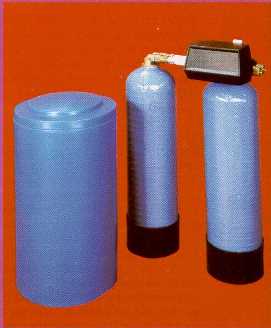 PUMPMASTERS LTD
PUMPMASTERS LTDUNIT 14A NASMYTH COURT HOUSTON INDUSTRIAL ESTATE LIVINGSTON, WEST LOTHIAN EH54 5EG, SCOTLAND, UK Tel: 01506 668740 Fax: 01506 668741 |
|||
|
|
|||
|
|
DUPLEX WATER SOFTENERS The Problems
The need to reduce the hardness of water is the most common form of water treatment. Hard water is created when naturally soft rain water percolates through subterranean rock strata and dissolves many solids including, in particular, calcium and magnesium. There are many areas therefore, where the water supply contains a significant level of these salts. It is called "hard water" because of the hard deposits created when this type of water is used in many systems.
The deposits are often called scale. However, it is actually more like concrete, forming a thick coating on heat exchanging elements and the inside of boilers, tanks and pipes. In addition, the hard minerals left in solution significantly detract from the performance of soaps and detergents which then have to be used in greater quantities to achieve the necessary cleaning performance. This not only adds to the level of deposits occurring inside systems and equipment, it also adds significantly to the chemical waste discharged into our sewer systems.
The other main problem created by scale build up is the reduction in efficiency of all heat exchange systems due to the insulating effect of the deposit. This will increase the energy costs and, in addition, can create overheating on the surfaces of the heat source, thereby causing premature failure.
The Solutions A cost effective way to solve these problems is to remove the dissolved hard mineral salts from the water, replacing or exchanging them with "soft salts" which are more soluble and therefore do not form hard scale. This is achieved by using one of our wide range of fully automatic water softeners. They work by a process known as ion exchange. The hard water passes through a high quality exchange resin column inside a pressure vessel. The resin removes the calcium and magnesium ions from the solution and exchanges them for sodium ions. When the resin is about to become exhausted the softener commences the regeneration phase which is initiated by timer or volume control. The actual regeneration is achieved when the softener draws a solution of common salt - called brine - through the column of resin which displaces the captured calcium and magnesium ions and replaces them with the sodium ions in the brine. Throughout the regeneration period the unwanted ions and all the subsequent rinsing is flushed to drain and does not enter the service line. The regeneration period takes between 60 and 120 minutes depending upon the size of the softener and it can be repeated as often as necessary over many years without significant loss of performance.
Duplex Softeners Duplex softeners function similarly to simplex units, except that they consist of two resin columns where one is in service and the second is on standby. The flow of water to service is metered and when the first column reaches exhaustion the control valve automatically switches the service flow to the second column and then regenerates the exhausted first column. It is then put on standby until required again for service. In this way a duplex softener is capable of giving a continuous 24 hour supply of softened water. Duplex softeners are therefore ideal for sites with large variations in water demand or for applications where a continuous and uninterrupted supply of soft water is essential. It is normal practice to size a duplex unit on the basis that each column regenerates once each day. Due to the ability to change columns only as required, it is possible to minimise salt usage.
Valve Specification Duplex control valves are sized and specified according to the required flow rate for the application. The inlet and outlet connection ports typically range between 1 -3 inches and in standard configurations can achieve flow rates of up to 40m3 per hour. Higher flow rates can be achieved using "side mounted" valves.
Specifying and Sizing The size of any water softener is governed by the amount of exchange capacity required for the application. The capacity of each ion exchange bed is a function of the volume of water passed through it and the hardness of the incoming water. The chart below shows the capacity of each standard size duplex unit we supply assuming that each resin column is regenerated once per day. It is possible periodically to allow for higher capacities than shown (up to two regenerations per column per day) to accommodate exceptional demand periods. The plant should not be sized in this way for routine use as there would be a danger of loss of quality of the softened water. The figures shown assume the fees water has a hardness of 300 mg/litre (21o Clarke). |
||

